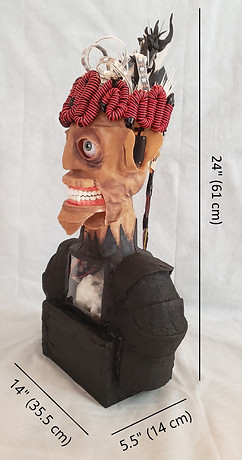
About
Due to the COVID-19 pandemic I am shifting the exhibition of my thesis project to a virtual format in which I document the conceptual development of the project and explain the process of its creation.
The main point behind my project is to show human emotion using electronic prototyping, servo motors, and light patterns to express machinic movement. Anxiety is the main emotion I focus on for this project. The sculpture shows a progression from comfort to discomfort in three stages. Being nervous and anxious in a crowd of people makes some humans act differently than they normally do, and this idea applies as well to a machine. At the beginning of my work, this behavior was designed to be triggered using a humidity sensor that allows for the environmental readings that change depending on human occupancy, time of day, air conditioning units, and so on. Moreover, the sculpture would behave normally when the surrounding place is empty and once the environment starts to become occupied, the machine would get increasingly nervous. The machine’s anxiety levels would increase as humidity data increases. However, due to the COVID-19 pandemic, I could not accomplish this type of experience using a sensor since it requires multiple tests to be run in public places to gather accurate data. I instead decided to create three stages of speed that help present the same idea of using a humidity sensor. The sculpture runs constantly ranging from a slow stage to average stage, to a fast stage and repeats them over and over. The slow stage represents the idea of being calm and acting normal when there are no large crowds, the average stage shows the onset of anxiety, and last demonstrates a state of extreme anxiety.
I am experimenting with emotion as a subject because it’s been my research interest since an undergraduate. I have expressed human emotions via the science of physiognomy for the outer appearance of a human especially the face by sculpting, drawing, and painting. However, this time I had the opportunity to use a different technique within the field of kinetic art. Nevertheless, the sculpture portrays its emotion and reaction through mechanized heartbeats, eye movements, talking, and brain signals composed of LED lights. Sculpting was my bachelor's first major, and it is the reason I chose to work with 3D printing and electronic prototyping. I am fascinated by kinetic works and I have always wanted to experiment with integrating traditional sculpting methods with coding and machines to produce moving sculptures. I have created many rigid sculptures using different types of materials like ceramic, wood, paper, and scrap assemblage. Since this is my first time working with machines, I decided to work with different materials to express my design. I used Worbla Scrap which is a modeling thermoplastic sheet that gets soft and gluey once it is heated so I can achieve the appearance of human skin and a hollowed sculpture that allows carrying all electronic components. I used three different colors of Worbla Scrap: skin color (classic), black, and transparent.
Sculpture's dimension:

